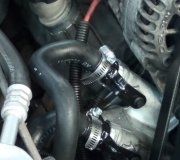This sounds like the same thing that was real common on the redesigned '96 Caravans. They used two rear heater hoses with plastic quick-connect fittings. Those had rubber o-rings that would shrink and leak in cold weather. When the vehicle was still under warranty, it could only be repaired by installing new parts, and in this case they developed an "improved" hose that had TWO o-rings in each connector that shrunk and leaked. Once the vehicle was out-of-warranty, we were free to get rid of those very expensive and troublesome hoses, and stick on regular heater hoses from a bulk package. The repair was much more reliable and permanent and it didn't cost very much.
The next problem is getting the air bled out. The best way we found was to use a hose pinch-off pliers on one of them, then loosen the hose clamp on that one when the engine was warmed up. The coolant was pressurized at that point and would get forced through the heater core, then out by the loose hose clamp. Once enough air was bled so some coolant would flow, eventually all the remaining air would bleed out. If you don't bleed the air out, no coolant will flow and you'll just get cold air for a few days or weeks, then all of a sudden it will self-bleed and start working, typically after the engine has been running at highway speed for a prolonged period of time.
Saturday, January 10th, 2015 AT 3:13 PM


